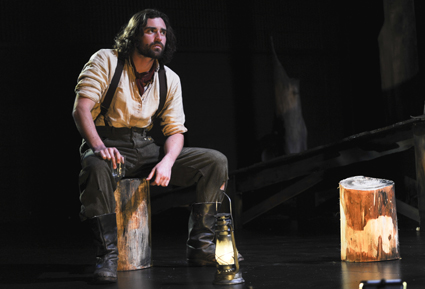a scarred colonial psyche
catherine mckinnon: marcell dorney’s charcoal creek

Johnny Carr, Charcoal Creek
photo Heidrun Löhr
Johnny Carr, Charcoal Creek
ANNE-LOUISE RENTELL’S PRODUCTION OF MARCEL DORNEY’S NEW PLAY, CHARCOAL CREEK, IMAGINES A PAST SHIMMERING WITH BRUTALITY. SET IN CHARCOAL CREEK, NSW (NOW UNANDERRA), IN THE LATE 1870s, THE LAND IS LUSH BUT DEVASTATION—THE MURDERING OF ABORIGINAL PEOPLE—HAS SCARRED THE ENVIRONMENT AND THE PSYCHE OF THE COLONIALS. THE NARRATIVE DOESN’T DEAL HEAD-ON WITH BLACK AND WHITE AUSTRALIA BUT INSTEAD RECREATES THE KINDLING OF FEAR AND PREJUDICE; THE BURNT LANDSCAPE OF THE MIND.
The play begins with its four characters—recent English arrivals, Charlotte (Olivia Beardsley) and husband Edward (Ed Wightman), and local dairy farmers Brigid (Catherine Moore) and husband Tom (Johnny Carr)—being drawn into swampy gloom to stand, like disembodied spirits, between tall, cindered trees. Running water, darkness, a metallic screeching. A slash of pulsating light reveals Brigid. Her mind ravaged by dreams, her fury fuelled by fear, she’s an Irish Elektra, an oppressed spirit seeking revenge, railing against the thunder, her husband’s snoring, her child’s crying and the unjust treatment of the Irish by the English. Her nighttime tirade foreshadows the play’s violent end and reflects Dorney’s interest in the way the past infuses terror into the present.
Charcoal Creek, humanist in perspective, asks universal questions. Does violence breed violence? Can past horrors be overcome? Can injustice be forgiven? Short scenes and poetic soliloquies unravel the shaping of a colonial community through a story of two households. Like Elektra, Brigid is the catalyst for murderous action. Although from invader stock herself, she views her new neighbours as invaders. Class division, family prejudices, historical injustices are to blame. Edward and Charlotte’s snobbery doesn’t help. Edward, a zealot for Darwin’s theory of natural selection, is in railway management and uninterested in farming. He bought the land for investment. Charlotte, a Bronte-reading romantic, gets bored and seduces Tom. Brigid’s revengeful impulses are unleashed. She sets the town against her neighbours with devastating consequences. When a raiding party passes by, flaming sticks in hand, she turns away. Dorney writes Tom as the martyr of the story. He embodies (perhaps too neatly) the clash of black and white Australia—his father responsible for hunting raids on Aboriginal people, his great grandfather, Aboriginal. Tom rushes to aid his neighbours, saving Charlotte (his child in her belly) but loses his own life.
Moore portrays Brigid as a bitter, stoic woman whose psyche is muddied by ingrained prejudices. Carr’s Tom is a good soul caught in forces beyond his control. Wightman juxtaposes Edward’s inner torment with outer jocularity. Beardsley’s Charlotte is intelligent and delightfully wicked. Anne-Louise Rentell’s theatrical landscape, moody and dark, is itself a pulsing spirit. Verity Hampson’s lighting creates a dynamic sculptural space where characters appear and disappear like magic tricks. Daryl Wallis’s sound design cleverly juxtaposes the natural with its industrial future. Imogen Ross’s costumes embody class division—Charlotte and Edward’s material lushness against Tom and Brigid’s common-sense fabrics.
There are some odd notes to this production: having decided upon an abstract set Rentell divides the forestage in two, one side for each household, and unnecessarily limits the playing space; the 20th century voice-overs seem out of place in the last moments of the play, yet would work wonderfully as the audience enters and exits; the off-stage references to children only highlight the fact they aren’t there; Moore does not take the opportunity to add vulnerability to Brigid’s interior monologues and the character’s stern exterior casts her too easily as the villain of the piece; Brigid’s costume, constantly neat and trim, never gives the sense of a working woman who must slosh around in the muck of cowsheds, nor of her nighttime instability.
But these are minor criticisms, remembering also that new plays need a first run in order to settle. Charcoal Creek is a tightly directed, thoughtfully realised production that enters the debate about prejudice from a colonial perspective through a conjuring of psychological landscapes.
Merrigong Theatre Company: Charcoal Creek, writer Marcel Dorney, director, designer, Anne-Louise Rentell, performers Olivia Beardsley, Johnny Carr, Catherine Moore, Ed Wightman, costumes Imogen Ross, lighting Verity Hampson, sound designer Daryl Wallis; Illawarra Performing Arts Centre, Illawarra, NSW, June 5–16
RealTime issue #110 Aug-Sept 2012 pg. 41






